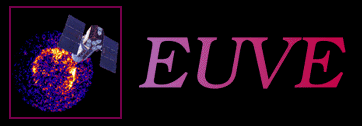
|
EUVE: New PostingsEUVE All-Sky and Deep Survey data available at the HEASARCDuring the first 6 months of its mission, EUVE carried out a survey of the entire sky in 4 filter bandpasses covering the wavelength region of 58-742 Angstroms. This dataset (originally distributed on 3 CD-Roms produced by the CEA in 2000) collects together the raw photon, exposure, and exposure-corrected photon sky maps for all survey bandpasses in the form of three-dimensional data cubes in FITS format. A more complete description of these data is available here. (Posted 2004 May 19).
EUVE SPACECRAFT RE-ENTERS EARTH'S ATMOSPHEREThe following is taken from the NASA News Release. "NASA's Extreme Ultraviolet Explorer (EUVE) re-entered the Earth's atmosphere at approximately 11:15 p.m. EST Wednesday. According to calculations made by the United States Space Command Space Control Center, EUVE re-entered the atmosphere over central Egypt. Using U.S. Space Command data, engineers calculated EUVE's orbit track and predicted where it could re-enter the atmosphere. EUVE did not have an on-board propulsion system to allow engineers to control the spacecraft's re-entry. EUVE was in a 28.5-degree orbit and could re-enter in any location within this orbit range. This range included areas as far north as Orlando, Fla., and as far south as Brisbane, Australia. The object was not designed to survive re-entry intact and was expected to break apart and mostly burn up in the atmosphere. U.S. Space Command cannot confirm if any pieces survived re-entry." (Posted 2002 January 31).
AGING NASA SPACECRAFT TO REENTER EARTH'S ATMOSPHEREis the headline of the NASA News Release and EUVE is the spacecraft!"Engineers at NASA Goddard Space Flight Center in Greenbelt, Md., predict a 7,000-pound spacecraft could re-enter the Earth's atmosphere as early as 10 p.m. EST on Jan. 30 or as late as 7 a.m. EST on Jan. 31. NASA's Extreme Ultraviolet Explorer (EUVE) is currently 200 kilometers (124 miles) above the Earth with a descent rate of 25 kilometers (15.5 miles) a day. The estimated debris field is expected to be 800 to 1,000 kilometers (500-625 miles). "The probability of the few EUVE surviving pieces falling into a populated area and hurting someone is very small. It is more likely that the small pieces will fall into the ocean or fall harmlessly to the ground," said Ronald E. Mahmot, Project Manager for Space Science Mission Operations at Goddard." (Posted 2002 January 29).
A guide to the EUVE Science Archive Data Products which was put together by the Center for Extreme-Ultraviolet Astrophysics (CEA) is available for download.Mark Abbott of CEA wrote this document which contains a summary description of the EUVE Science Archive pointed products. It is meant to be used as a supplement to the older EUVE Software Users' Guide and EUVE Data Products Guide. The Science Archive Data Products is available at the HEASARC ftp site in both PDF format (129 Kb) and PostScript format (965 Kb). (Updated 2001 December 7).
The HEASARC Archive of EUVE pointing-mode spectroscopic observations is now complete and all datasets are publically availableOn October 1, 2001 the last proprietary EUVE datasets became public. All EUVE pointing-mode spectroscopic observations are available in the HEASARC's anonymous ftp area. These new observations are most easily available using the the EUVEMASTER Catalog that is available via the Web Browse) interface. (Updated: 2001 October 9).
The Center for Extreme Ultraviolet Astronomy (CEA) is now closed, including the ftp and Web sitesOn March 27 2001, the CEA ftp and Web sites were closed down, although some of the Web pages were moved to the main UC Berkeley Space Sciences Laboratory Web site. The HEASARC copied the contents of the CEA ftp and Web sites over before they closed and is in the process of re-organizing its own EUVE ftp area and Web pages to incorporate this material. (Posted 2001 March 27).
Final EUVE Calibration Observation ResultsA report on a final series of calibration observations made with the EUVE Satellite is now available. The stars selected were the usual EUVE calibration targets HZ 43 (spectrometer) and GD 153 (scanner) for throughput, and Capella for the wavelength solution. The observations were made between 9-16 January 2001, during the last month of EUVE operations. (Posted 2001 March 27).
EUVE Operations are EndedIn the summer of 2000, NASA decided that EUVE mission operations should cease within a few months. EUVE science operations ended on January 26, 2001, and there followed several days of end-of-life mission engineering tests of the never-used backup high voltage supplies and checking of the remaining battery capacity. EUVE was stabilized pointing away from the Sun and sent into safehold at 23:59 UTC on Jan 31 2001. The transmitters were finally commanded off on Feb 2 2001. EUVE is now in a 424 x 433 km x 28.4 deg orbit and will probably reenter sometime in 2002. (Posted 2001 February 6).
End of EUVE Announcement from NASA(Posted 2000 November 21).
EUVE data archived at the HEASARCLate in 1997, NASA decided that the EUVE final data archive responsibilities should be transferred from the Center for Extreme-Ultraviolet Astrophysics (CEA) to the HEASARC, the Multi-Mission Archive at the Space Telescope (MAST), and the National Space Sciences Data Center (NSSDC). The HEASARC's role is to serve the EUVE data and act as an interface for the community of high-energy (X-ray and gamma-ray) astrophysicists, the STScI's is to provide similar access to the optical and UV community and to maintain the EUVE IRAF based software package, while the NSSDC's role is to act as a deep archive for EUVE data and to service requests for large amounts of data, i.e., for amounts of data that are infeasible to retrieve over the Internet/WWW.
What EUVE datasets does the HEASARC have?
What is the easiest way to select the desired EUVE datasets?
|



